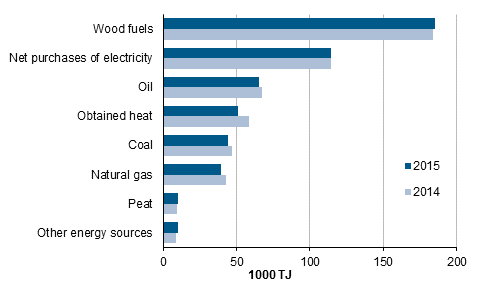Published: 3 November 2016
Energy use in manufacturing diminished by 3 per cent in 2015
According to Statistics Finland, energy use in manufacturing decreased by three per cent from the previous year in 2015. Manufacturing consumed 504 petajoules (PJ) of energy. The total use of electricity in manufacturing decreased by two per cent.
Use of energy in manufacturing

In 2015, the volume of industrial output decreased further from one year earlier, which was also reflected in the use of energy. Energy consumption decreased for the fifth consecutive year ending up close to 2009 figures seen after the drop following the financial crisis.
The main source of energy was wood fuels, whose share was 37 per cent. The consumption of wood fuels remained almost on level with the previous year. The second most significant group in fuels was oil products, whose consumption increased slightly. Together, wood fuels and oil products cover one-half of fuels used by manufacturing. The consumption of all other energy sources decreased year-on-year.
The consumption of fuels fluctuates annually due to many factors. The use of fuels is affected by the prices of fuels and emission rights, availability, possible changes in taxation, industry-specific development of manufacturing, etc. In this decade, the drop in fuels used by manufacturing has, however, been trend-like in fossil fuels and peat. The consumption of wood fuels has, in turn, grown, while the total consumption of fuels has declined, which means that the share of wood fuels in all used fuels has increased evenly.
Consumption of electricity amounted to close on 39 terawatt hours (TWh), down by two per cent year-on-year. The consumption of electricity in manufacturing has remained fairly stable throughout this decade fluctuating only by a few percentages from one year to another. By contrast, the drop from the level prevailing prior to the financial crisis is over 20 per cent, which is the case in almost all other fuels apart from wood fuels.
Despite the decrease in its share, the forest industry is still clearly the biggest user of electricity in manufacturing with a share of nearly 50 per cent. When manufacturing consumes nearly one-half of electricity in Finland, the share of the forest industry is close to one-quarter of total electricity consumption. After the forest industry, the main industries are the chemical industry and the manufacture of metals, which combined consume one-third of electricity use in manufacturing. In most industries, electricity consumption has been declining in the current decade, with mining and quarrying and the manufacture of metals as the only considerable exceptions.
The consumption of heat decreased by over seven per cent year-on-year. Heat used by manufacturing includes both industrial heat and district heat. The consumption of district heat declined from the year before due to the warm weather that decreased the need to heat buildings. The consumption of industrial heat has decreased by one-third in this decade. In addition to the ongoing structural change in industry in Finland this is also affected by structural changes in the business sector. Steam produced by manufacturing enterprises for own use is visible in the statistics as consumed fuels but if the steam is produced by another enterprise in the energy sector, the consumption of steam is visible as purchased steam and the consumption of fuels used to produce the steam as fuels used by the energy sector. Thus, a transfer of ownership of a power plant can in part be visible as structural changes.
The energy consumption of manufacturing differs considerably when examined by region. When examined by region, more than one-half of the energy consumed by manufacturing is used within four regions. Uusimaa, South Karelia, North Ostrobothnia and Lapland are responsible for a majority of the energy consumed by manufacturing in Finland. The regional profile is determined by the placement of energy-intensive industries. The location of the big units in the manufacture of metals, forest industry and chemical industry determines where most energy is consumed.
Source: Energy use in manufacturing, Statistics Finland
Inquiries: Anssi Vuorio 029 551 3668, energia@tilastokeskus.fi
Director in charge: Ville Vertanen
Publication in pdf-format (285.8 kB)
- Tables
-
Appendix tables
- Figures
-
- Appendix figure 1. Use of energy in manufacturing (3.11.2016)
- Appendix figure 2. Energy use in manufacturing by energy source 2015 (3.11.2016)
- Appendix figure 3. Energy use in manufacturing by industry (3.11.2016)
- Appendix figure 4. Energy use in manufacturing by region (3.11.2016)
- Appendix figure 5. Total electricity consumption in manufacturing 2015 (3.11.2016)
- Appendix figure 6. Total electricity consumption by manufacturing branch (3.11.2016)
- Appendix figure 7. Total electricity consumption in manufacturing by region (3.11.2016)
Updated 3.11.2016
Official Statistics of Finland (OSF):
Energy use in manufacturing [e-publication].
ISSN=1798-7776. 2015. Helsinki: Statistics Finland [referred: 15.12.2025].
Access method: http://stat.fi/til/tene/2015/tene_2015_2016-11-03_tie_001_en.html

